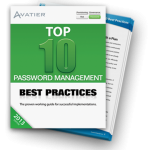It’s a strange duality of today’s society that as things become more automated, people are seeking ways to get back to “doing it yourself”. We see this manifested in the form of an entire network on cable TV devoted to “do it yourself” (the DIY Network). We’ve also seen it in business, though, where responsibility for something like active directory password reset, which can potentially swamp IT Departments and help desks with requests or simply go unattended, is being handed back to employees in the form of automated password reset tools so they can reset passwords themselves.
While on an individual level, the DIY movement is inspired by some inner desire for independence or that good feeling of accomplishment, in the business world the move has been one of necessity. This is particularly true with Healthcare IT where reduced growth in Medicare and Medicaid reimbursements combined with a rising number of patients is forcing organizations rethink their operations namely how to do more with less.
This isn’t an easy proposition when it comes to ensuring patient information including medical images, test results, and insurance and payment information — is readily accessible to doctors, nurses and healthcare professionals, whether working onsite or remotely. Access to view such privileged information and schedule patient care naturally requires passwords for security, and managing passwords resets for so many physicians, staff and area providers can prove challenging for IT support professionals.
This is why Georgia’s Gwinnett Medical Center (GMC) initiated self-service active directory password reset in 2005. Now, 800 physicians and their associated staff numbering over 2000 accounts manage their own passwords.
As Rick Allen, vice president of Information Security at Gwinnett explains, “At the time, requests for active directory password resets were overwhelming our help desk, so Avatier’s Password Management was put in place to allow physicians and their office staff — which could be as many as 30 people in one office — to manage, reset or otherwise keep up with their own passwords. This way, we weren’t eating our own help desk cycles and were creating more efficiency. And physicians and their staff could more quickly get to the information they needed to be effective in their jobs.”
The proof of the effectiveness of conducting password management through self-service active directory password reset is practically self-evident. Allen is able to run a report of all Password Management Active Directory resets and report how much help desk money was saved with automatic versus manual resets.
Since the implementation of Password Management in 2005 through October 2012, GMC has saved approximately 73,845 administrative hours, which translates to an estimated cost savings that exceeds $1.1 million!
Gwinnett has further streamlined its password management challenges by purchasing a connector pack from Avatier. With this, Gwinnett was able to synchronize passwords across its Lawson, McKesson HCI and HPF, and Sunquest systems. Now, when a user changes their primary Active Directory password, passwords are automatically changed on all the other key systems. Password synchronization alone contributed to a help desk password reset request decrease, as users had only one password to remember.
Watch the Avatier Password Management Product Introduction video to learn more about our password reset software solutions:
 Get Your Free Top 10 Password Management Best Practices Guide
Get Your Free Top 10 Password Management Best Practices Guide
Learn the Top 10 Password Management Best Practices for successful implementations from industry experts. Use this guide to sidestep the challenges that typically derail enterprise password management projects.




